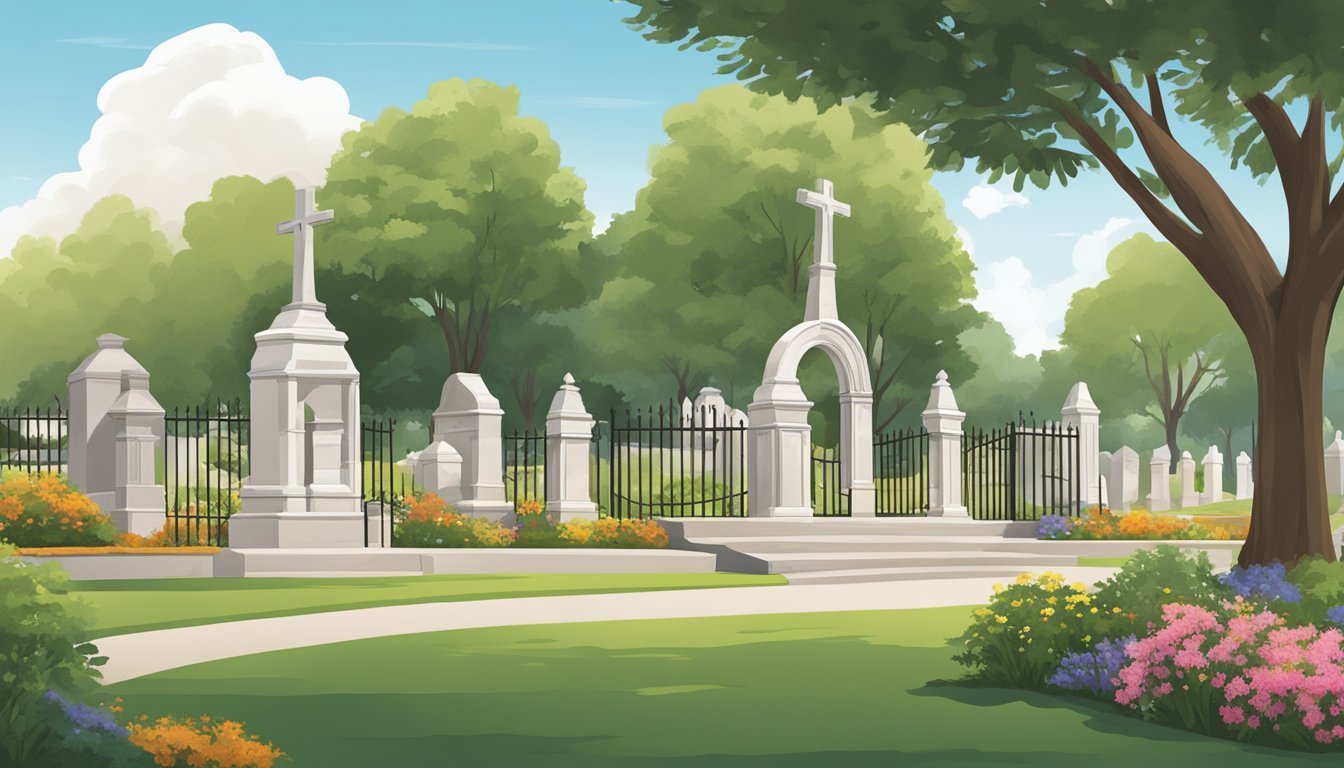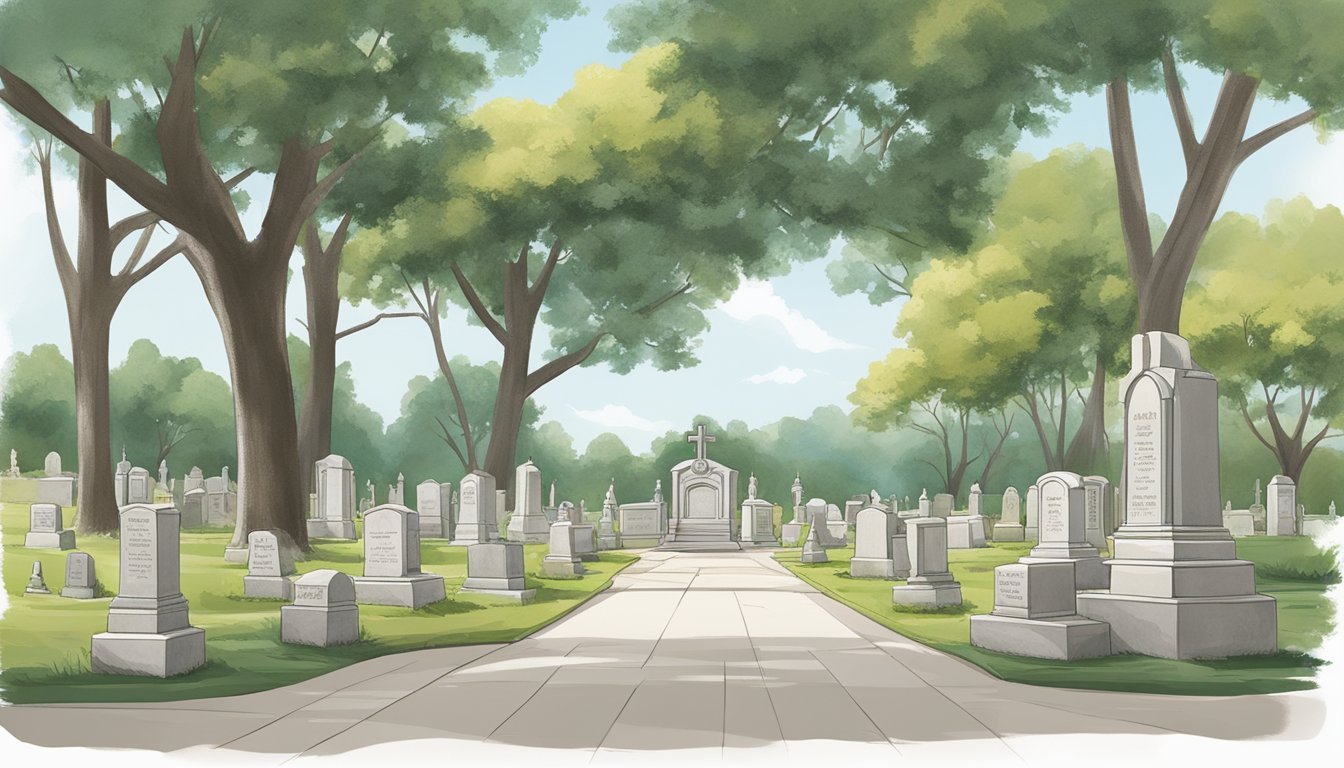Cemeteries in Austin Texas
An Insightful Guide to Historic and Modern Burial Sites
Austin, Texas, a city known for its vibrant music scene and rich history, is also home to a variety of cemeteries that add a solemn and reflective aspect to its cultural tapestry. These cemeteries serve as final resting places, historical repositories, and green spaces within the urban landscape. They range from small family plots to large municipal resting grounds, each carrying stories of the individuals who helped shape the city into what it is today.
One of the oldest city-owned cemeteries is Oakwood Cemetery, which provides a panoramic view of the downtown area and acts as a quiet escape from the bustling city life. Established in the 19th century, it captures a piece of Austin's past with monuments that pay homage to the notable figures buried there. Additionally, the city operates a number of other municipal cemeteries including Austin Memorial Park, Evergreen Cemetery, and Plummers Cemetery, each with its own unique narrative.
Furthermore, there are specialized cemeteries such as the Bethany Memorial Gardens Columbarium and the Cook Walden Forest Oaks Memorial Park, offering a variety of burial options for residents. These sites are meticulously maintained, ensuring the preservation of the history and the serene environment that are characteristic of Austin's cemeteries. They not only provide solace for the living but are also a testament to the diverse heritage of this Texas city.
History of Austin's Cemeteries
Austin's cemeteries serve as final resting places for notable individuals and reflect the city's historical journey. They are managed with a focus on preservation and respect for the past.
Early Burial Grounds
The origins of burial grounds in Austin trace back to the mid-1850s when the city was still young. Oakwood Cemetery, Austin's oldest cemetery, was established in this era, and its grounds have borne witness to the evolving history of the city.
Notable Cemeteries
Two prominent cemeteries in Austin are the Texas State Cemetery and Oakwood Cemetery. The Texas State Cemetery is the burial site of many significant figures in Texas's state history and politics. It also includes the grave of acclaimed writer James A. Michener. Oakwood Cemetery, distinguished by its hilltop location near downtown Austin, is known for historical Civil War monuments and the resting places of many of Austin's early settlers and leaders.
Preservation Efforts
The preservation of these historical sites is overseen by entities such as the Texas Historical Commission. Protective efforts ensure that the integrity and the historical significance of Austin's cemeteries are maintained for future generations. Programs like "Historical Biographies of Austin Cemeteries" aim to keep the stories of those interred alive, enhancing the cultural tapestry of the city.
Types of Cemeteries in Austin
In Austin, Texas, cemeteries are as varied as the city's history, ranging from public resting places to private family plots and specialty cemeteries that cater to specific groups such as veterans.
Public Cemeteries
The Austin Parks and Recreation Department operates five municipal cemeteries that are open to the public. These include:
Austin Memorial Park Cemetery, which offers a space where residents can honor their loved ones.
Evergreen Cemetery, known for its historical significance, and resting place for many notable citizens.
Oakwood Cemetery, Austin's oldest city-owned cemetery, and the Oakwood Annex Cemetery.
Plummers Cemetery, a smaller but historically rich burial ground.
These cemeteries are well-maintained and are significant for their historical, cultural, and social values, reflecting the diverse heritage of the city.
Private Family Cemeteries
There are also private family cemeteries throughout Austin that serve individual families or smaller communities. An example includes:
Historical family graveyards that often preserve the legacies of Austin’s early settlers and are typically found on private property, reflecting a more personal family heritage.
Austin’s private cemeteries offer a more exclusive and typically quieter resting place for those with specific family ties to the area.
Specialty Cemeteries
Specialty cemeteries in Austin cater to specific groups, offering dedicated space for individuals united by common experiences or affiliations:
Veterans and their families may find dedicated spaces in cemeteries like the Texas State Cemetery, which includes gravesites for soldiers and notable Texas Rangers.
Religious and cultural groupings are also reflected, with various cemeteries offering plots to those groups, ensuring practices align with their traditions and beliefs.
These specialty cemeteries provide a sense of community and shared history for their interred members.
Services and Amenities
In Austin, Texas, the cemeteries offer a range of services and amenities designed to cater to the diverse needs of bereaved families and visitors, ensuring comfort, respect, and lasting memorials.
Burial Options
Austin's cemeteries provide a variety of burial options to accommodate individual preferences and traditions. They include:
Traditional in-ground burial plots
Options for the interment of cremated remains
Each cemetery plot is maintained with care to honor the memory of those laid to rest.
Memorial Services
Cemeteries in Austin are equipped to host memorial services with dignity. Key elements include:
Spaces for gatherings and remembrance
Support for arranging funeral services
Families receive assistance with the necessary arrangements to ensure services proceed smoothly.
Visitor Comforts
Visitor comforts are a priority, and Austin's cemeteries feature:
Well-maintained grounds open daily from 7 am to 7 pm
Seating and shaded areas for reflection and repose
These amenities provide visitors a tranquil environment for paying respects.
Legal and Administrative Aspects
In Austin, Texas, legislation ensures the well-regulated operation of cemeteries, encompassing aspects like management, costs, and adherence to standards. Processes for fees, costs, and cemetery management are explicitly defined within the legislative framework.
Legislation and Regulation
Texas law, through chapters 711-715 of the Texas Health and Safety Code and additional municipal regulations, mandates how cemeteries should be administered. The City of Austin follows these codes and has implemented rules specific to city-maintained cemeteries, including a master plan that guides future development and burials. The legislature requires that cemeteries adhere to codes that detail everything from the sale of plots to the maintenance of grave sites.
Fees and Costs
The City of Austin sets forth clear guidelines for fees associated with cemetery operations. These can include the purchase of plots, burial costs, and maintenance fees. A review of costs is periodically conducted to ensure they remain fair and consistent with the necessary upkeep and services provided by cemetery administration.
Cemetery Management
Management of cemeteries in Austin is overseen by a dedicated division of the Parks and Recreation Department. They are responsible for more than 200 acres across several municipal cemeteries. Administrative staff handle day-to-day operations, while grounds staff ensure the cemeteries are well-maintained. The management team is tasked with implementing the master plan and ensuring regulations are followed, which includes periodic reviews of operations.
Health and Safety Standards
Ensuring the health and safety standards of cemeteries in Austin, Texas, involves strict adherence to established guidelines. These regulations protect the public and preserve the dignity of the facilities.
Maintenance Protocols
Grounds Maintenance: The City of Austin mandates regular upkeep of cemetery grounds to prevent overgrowth and maintain a respectful appearance. This includes routine mowing, trimming, and debris removal, essential for both aesthetic and health reasons in Travis County.
Structural Upkeep: Cemetery authorities are tasked with the inspection and maintenance of structures such as mausoleums and fences to ensure they abide by safety codes.
Public Safety Measures
Access Regulations: Public safety requires controlling access to cemetery areas, with measures in place to prevent vandalism and maintain a safe environment for visitors.
Emergency Response: Austin cemeteries are equipped with protocols to swiftly address accidents or health-related incidents, crucial in a North American urban setting.
These measures reflect the city's commitment to the safety and well-being of its communities, encompassing health and safety aspects within its cemetery operations.
Choosing a Final Resting Place
Selecting an appropriate final resting place is a significant decision for a family or individual. This section details the steps one would take within Austin, TX, to ensure their choice meets their needs for remembrance and legacy.
Selecting a Cemetery
When choosing a cemetery in Austin, one should consider the location, historical significance, and the amenities offered. Cook-Walden/Forest Oaks Memorial Park is an option that provides a tranquil environment for reflection, operating from sunrise to sunset. Another notable location, the Texas State Cemetery, houses the gravesites of prominent Texas figures.
Purchasing a Plot
Acquiring a plot involves contacting the cemetery's administrative offices to discuss availability and pricing. For example, reaching out to Cemetery Operations at 512-978-2320 can help one understand the services and rules of municipal cemeteries like Austin Memorial Park and Evergreen Cemetery.
Planning Ahead
Making arrangements in advance can provide peace of mind. Members within the community are encouraged to plan ahead, securing a spot that reflects the life and legacy of the ever-loved individual. One should consider aspects like:
Burial Type: Traditional in-ground, mausoleum, or cremation niches.
Location Within the Cemetery: Proximity to paths, water features, or trees.
Personal Preferences: Accessibility and regulations that fit personal or cultural practices.
Conclusion
Characteristic of Austin’s respect for its heritage, the cemeteries within its bounds stand as silent custodians of history. Among these, Oakwood Cemetery, perched on a hill east of I-35, dates back to the mid-1850s and offers a view of the city’s evolution. Its location, once isolated, now finds itself embraced by the city's growth.
The Old South Austin Cemetery represents the oldest of these sanctuaries, preserving the city's narratives through its monuments and headstones. The significance of these sites extends beyond mere burial grounds; they are crucial cultural touchstones reflecting Austin's journey through time.
In addition to these historical sites, Austin's dedication to its past is evident in the ongoing discussions to update the cemetery rules, reflective of changing norms and needs of modern society. Austin Parks and Recreation signifies this commitment through planned renovations while maintaining respect for historical preservation.
The cemeteries of Austin, Texas are not only places of rest but also chronicles of the city's rich past. They stand as open-air archives, where visitors and locals alike can traverse amidst the whispers of long-gone eras. Each cemetery, with its unique past and preservation, contributes to the complex tapestry that is Austin's history.






